Analysis of Healthcare Quality and Safety: Bundaberg Hospital Inquiry
VerifiedAdded on 2023/01/05
|9
|1883
|54
Report
AI Summary
This report critically examines the public inquiry into the healthcare system failure at Bundaberg Hospital in Queensland, focusing on the inadequacies that led to patient harm. It analyzes two key modules: 'Quality and Safety' and 'Organizational Culture.' The report highlights the lack of adherence to quality and safety standards, including inadequate incident reporting, failure to address complaints, and absence of accreditation and benchmarking. It also explores the detrimental impact of a market-based organizational culture and an autocratic environment that suppressed whistleblowers, such as Toni Hoffman. The report references the National Safety and Quality Health Service Standards (NSQHS) and suggests that adherence to these standards, along with adopting clan and adhocracy organizational cultures, could have prevented the failures. The conclusion emphasizes the need for open communication, transparency, and stringent quality regulations to prevent similar incidents in the future.
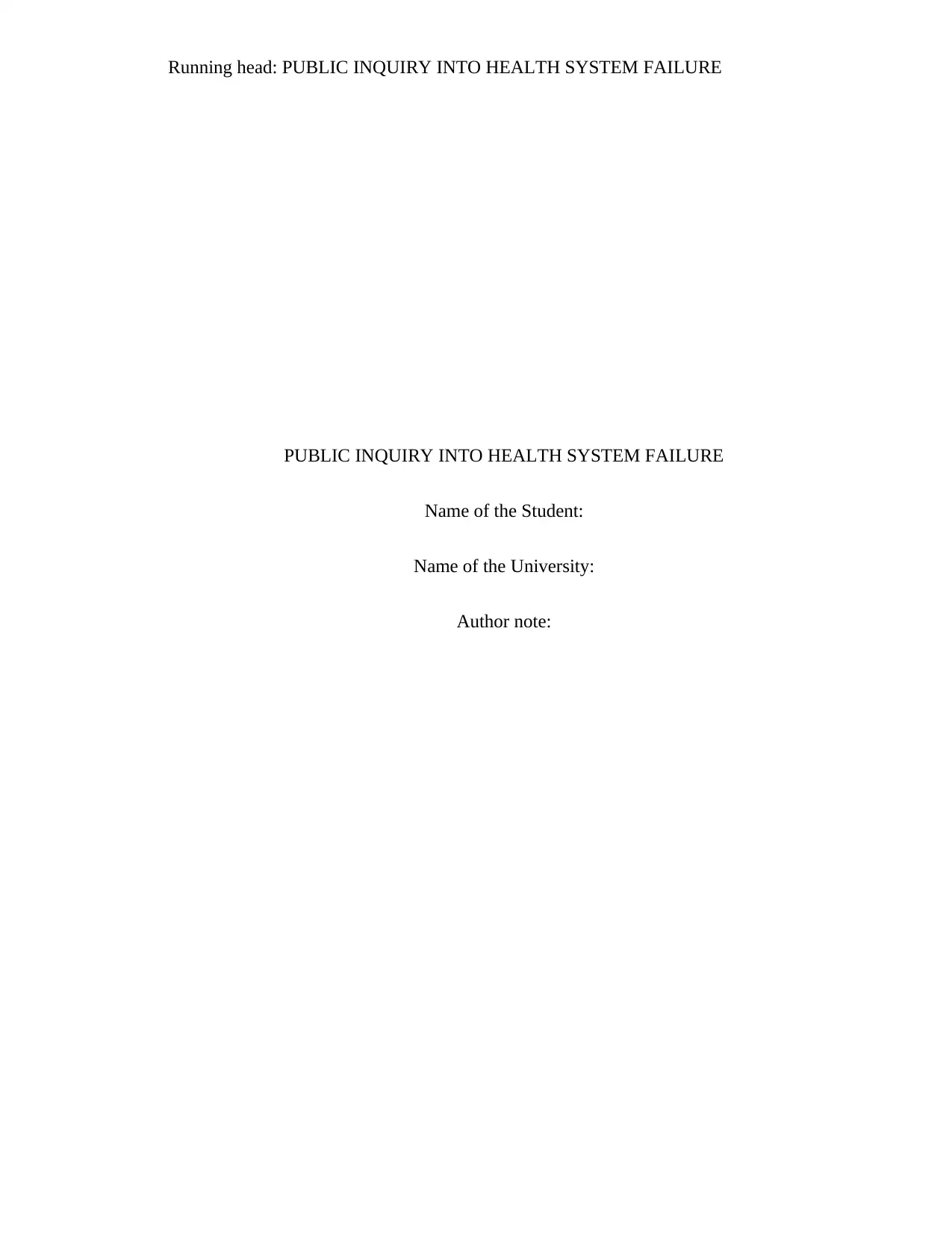
Running head: PUBLIC INQUIRY INTO HEALTH SYSTEM FAILURE
PUBLIC INQUIRY INTO HEALTH SYSTEM FAILURE
Name of the Student:
Name of the University:
Author note:
PUBLIC INQUIRY INTO HEALTH SYSTEM FAILURE
Name of the Student:
Name of the University:
Author note:
Paraphrase This Document
Need a fresh take? Get an instant paraphrase of this document with our AI Paraphraser
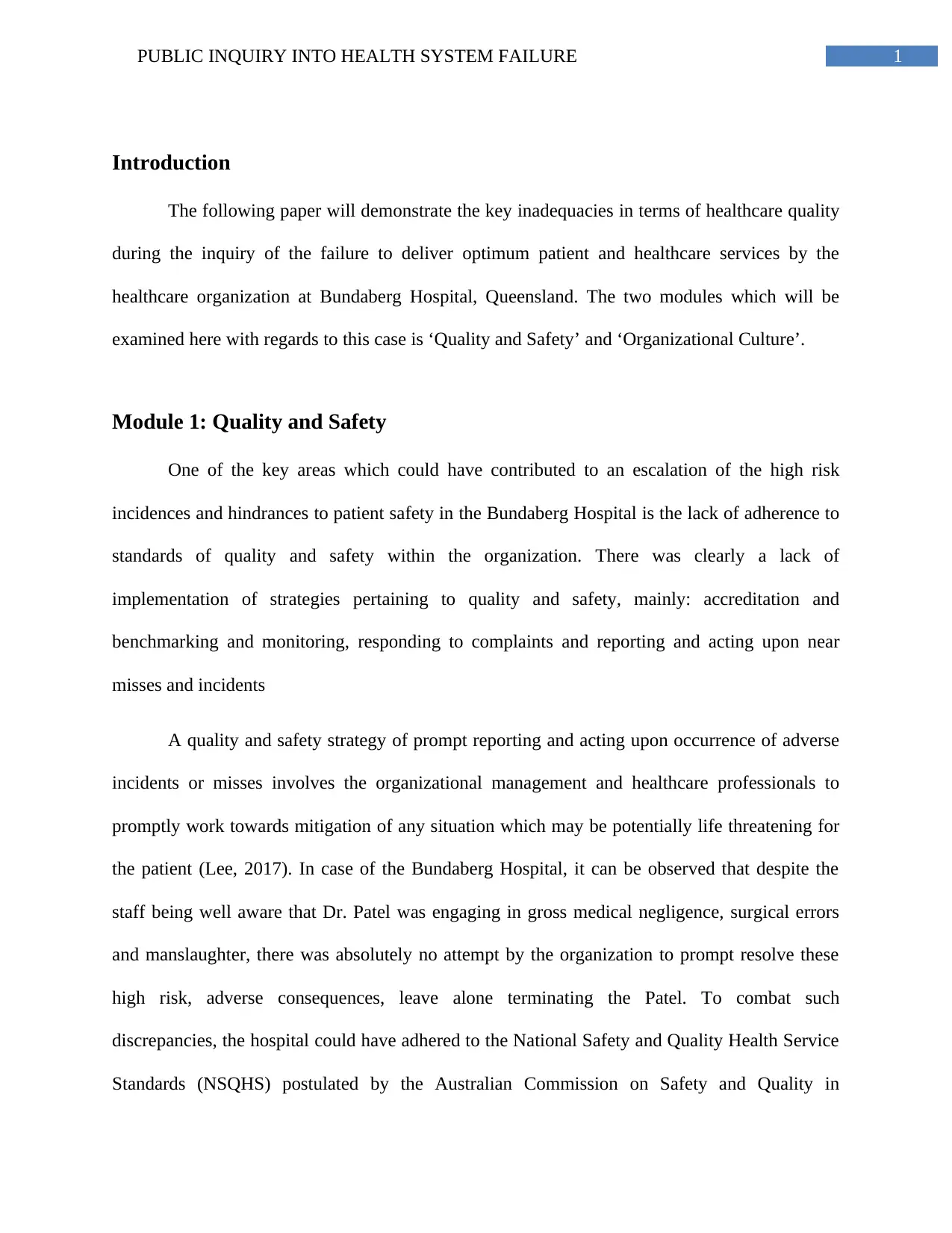
1PUBLIC INQUIRY INTO HEALTH SYSTEM FAILURE
Introduction
The following paper will demonstrate the key inadequacies in terms of healthcare quality
during the inquiry of the failure to deliver optimum patient and healthcare services by the
healthcare organization at Bundaberg Hospital, Queensland. The two modules which will be
examined here with regards to this case is ‘Quality and Safety’ and ‘Organizational Culture’.
Module 1: Quality and Safety
One of the key areas which could have contributed to an escalation of the high risk
incidences and hindrances to patient safety in the Bundaberg Hospital is the lack of adherence to
standards of quality and safety within the organization. There was clearly a lack of
implementation of strategies pertaining to quality and safety, mainly: accreditation and
benchmarking and monitoring, responding to complaints and reporting and acting upon near
misses and incidents
A quality and safety strategy of prompt reporting and acting upon occurrence of adverse
incidents or misses involves the organizational management and healthcare professionals to
promptly work towards mitigation of any situation which may be potentially life threatening for
the patient (Lee, 2017). In case of the Bundaberg Hospital, it can be observed that despite the
staff being well aware that Dr. Patel was engaging in gross medical negligence, surgical errors
and manslaughter, there was absolutely no attempt by the organization to prompt resolve these
high risk, adverse consequences, leave alone terminating the Patel. To combat such
discrepancies, the hospital could have adhered to the National Safety and Quality Health Service
Standards (NSQHS) postulated by the Australian Commission on Safety and Quality in
Introduction
The following paper will demonstrate the key inadequacies in terms of healthcare quality
during the inquiry of the failure to deliver optimum patient and healthcare services by the
healthcare organization at Bundaberg Hospital, Queensland. The two modules which will be
examined here with regards to this case is ‘Quality and Safety’ and ‘Organizational Culture’.
Module 1: Quality and Safety
One of the key areas which could have contributed to an escalation of the high risk
incidences and hindrances to patient safety in the Bundaberg Hospital is the lack of adherence to
standards of quality and safety within the organization. There was clearly a lack of
implementation of strategies pertaining to quality and safety, mainly: accreditation and
benchmarking and monitoring, responding to complaints and reporting and acting upon near
misses and incidents
A quality and safety strategy of prompt reporting and acting upon occurrence of adverse
incidents or misses involves the organizational management and healthcare professionals to
promptly work towards mitigation of any situation which may be potentially life threatening for
the patient (Lee, 2017). In case of the Bundaberg Hospital, it can be observed that despite the
staff being well aware that Dr. Patel was engaging in gross medical negligence, surgical errors
and manslaughter, there was absolutely no attempt by the organization to prompt resolve these
high risk, adverse consequences, leave alone terminating the Patel. To combat such
discrepancies, the hospital could have adhered to the National Safety and Quality Health Service
Standards (NSQHS) postulated by the Australian Commission on Safety and Quality in
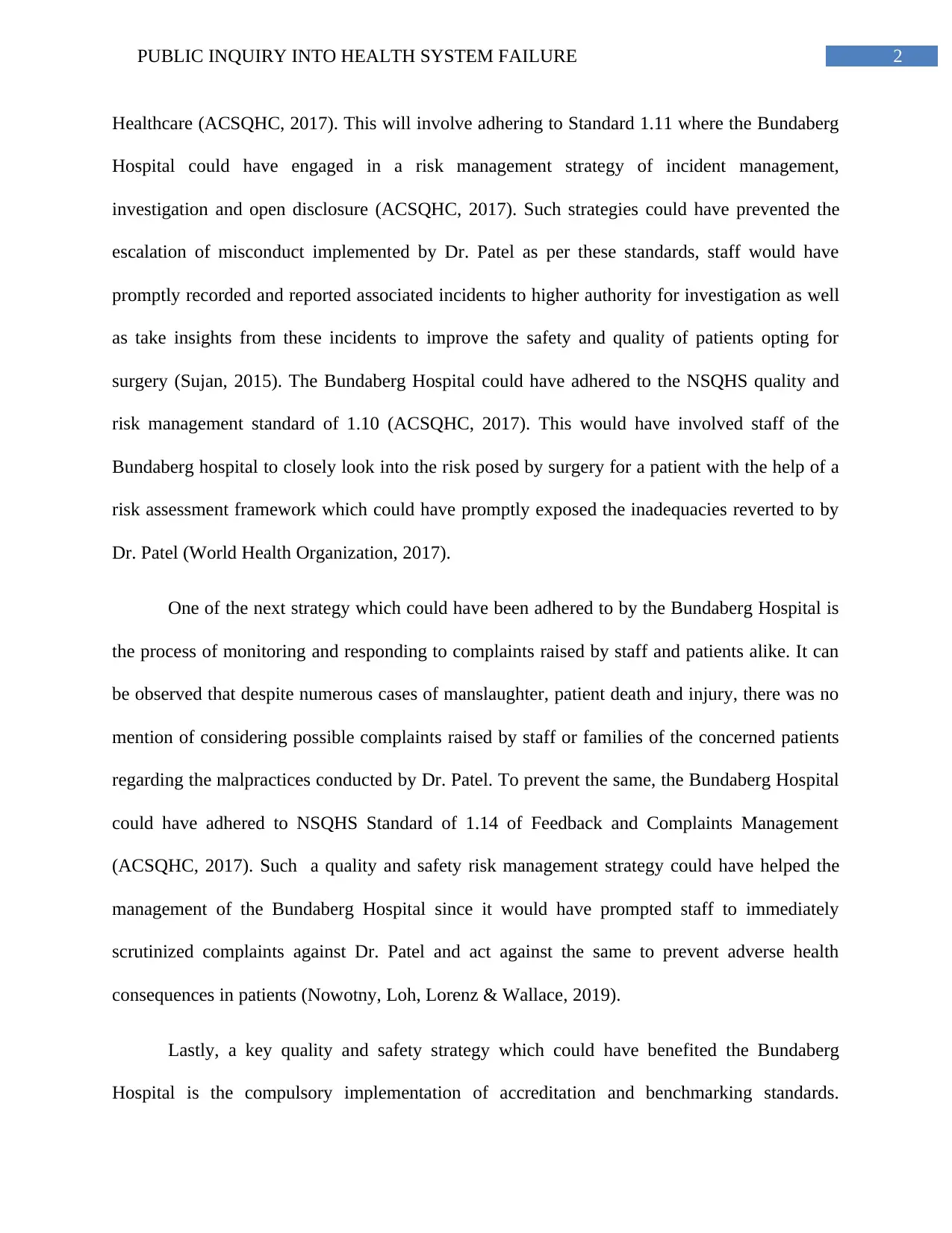
2PUBLIC INQUIRY INTO HEALTH SYSTEM FAILURE
Healthcare (ACSQHC, 2017). This will involve adhering to Standard 1.11 where the Bundaberg
Hospital could have engaged in a risk management strategy of incident management,
investigation and open disclosure (ACSQHC, 2017). Such strategies could have prevented the
escalation of misconduct implemented by Dr. Patel as per these standards, staff would have
promptly recorded and reported associated incidents to higher authority for investigation as well
as take insights from these incidents to improve the safety and quality of patients opting for
surgery (Sujan, 2015). The Bundaberg Hospital could have adhered to the NSQHS quality and
risk management standard of 1.10 (ACSQHC, 2017). This would have involved staff of the
Bundaberg hospital to closely look into the risk posed by surgery for a patient with the help of a
risk assessment framework which could have promptly exposed the inadequacies reverted to by
Dr. Patel (World Health Organization, 2017).
One of the next strategy which could have been adhered to by the Bundaberg Hospital is
the process of monitoring and responding to complaints raised by staff and patients alike. It can
be observed that despite numerous cases of manslaughter, patient death and injury, there was no
mention of considering possible complaints raised by staff or families of the concerned patients
regarding the malpractices conducted by Dr. Patel. To prevent the same, the Bundaberg Hospital
could have adhered to NSQHS Standard of 1.14 of Feedback and Complaints Management
(ACSQHC, 2017). Such a quality and safety risk management strategy could have helped the
management of the Bundaberg Hospital since it would have prompted staff to immediately
scrutinized complaints against Dr. Patel and act against the same to prevent adverse health
consequences in patients (Nowotny, Loh, Lorenz & Wallace, 2019).
Lastly, a key quality and safety strategy which could have benefited the Bundaberg
Hospital is the compulsory implementation of accreditation and benchmarking standards.
Healthcare (ACSQHC, 2017). This will involve adhering to Standard 1.11 where the Bundaberg
Hospital could have engaged in a risk management strategy of incident management,
investigation and open disclosure (ACSQHC, 2017). Such strategies could have prevented the
escalation of misconduct implemented by Dr. Patel as per these standards, staff would have
promptly recorded and reported associated incidents to higher authority for investigation as well
as take insights from these incidents to improve the safety and quality of patients opting for
surgery (Sujan, 2015). The Bundaberg Hospital could have adhered to the NSQHS quality and
risk management standard of 1.10 (ACSQHC, 2017). This would have involved staff of the
Bundaberg hospital to closely look into the risk posed by surgery for a patient with the help of a
risk assessment framework which could have promptly exposed the inadequacies reverted to by
Dr. Patel (World Health Organization, 2017).
One of the next strategy which could have been adhered to by the Bundaberg Hospital is
the process of monitoring and responding to complaints raised by staff and patients alike. It can
be observed that despite numerous cases of manslaughter, patient death and injury, there was no
mention of considering possible complaints raised by staff or families of the concerned patients
regarding the malpractices conducted by Dr. Patel. To prevent the same, the Bundaberg Hospital
could have adhered to NSQHS Standard of 1.14 of Feedback and Complaints Management
(ACSQHC, 2017). Such a quality and safety risk management strategy could have helped the
management of the Bundaberg Hospital since it would have prompted staff to immediately
scrutinized complaints against Dr. Patel and act against the same to prevent adverse health
consequences in patients (Nowotny, Loh, Lorenz & Wallace, 2019).
Lastly, a key quality and safety strategy which could have benefited the Bundaberg
Hospital is the compulsory implementation of accreditation and benchmarking standards.
⊘ This is a preview!⊘
Do you want full access?
Subscribe today to unlock all pages.

Trusted by 1+ million students worldwide
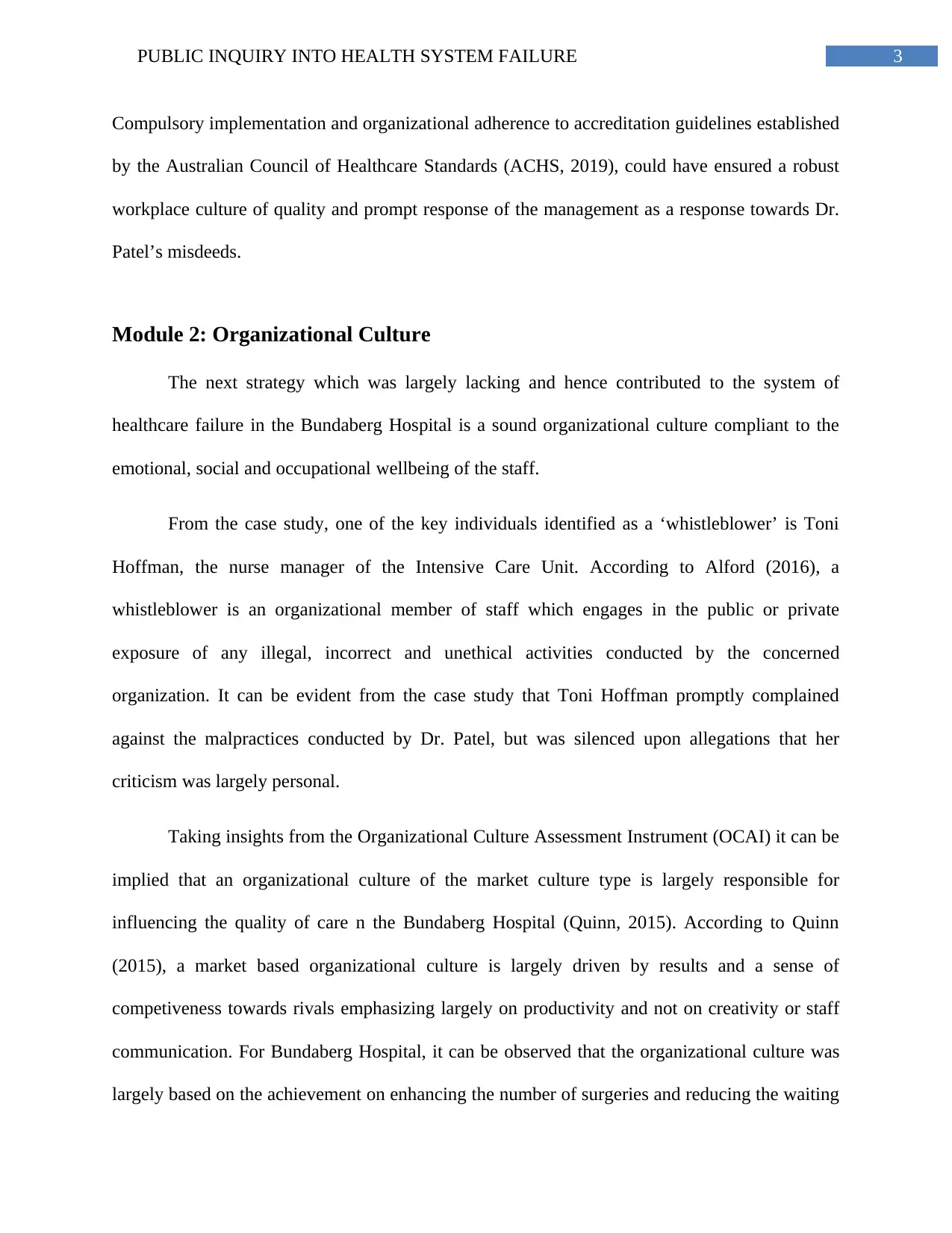
3PUBLIC INQUIRY INTO HEALTH SYSTEM FAILURE
Compulsory implementation and organizational adherence to accreditation guidelines established
by the Australian Council of Healthcare Standards (ACHS, 2019), could have ensured a robust
workplace culture of quality and prompt response of the management as a response towards Dr.
Patel’s misdeeds.
Module 2: Organizational Culture
The next strategy which was largely lacking and hence contributed to the system of
healthcare failure in the Bundaberg Hospital is a sound organizational culture compliant to the
emotional, social and occupational wellbeing of the staff.
From the case study, one of the key individuals identified as a ‘whistleblower’ is Toni
Hoffman, the nurse manager of the Intensive Care Unit. According to Alford (2016), a
whistleblower is an organizational member of staff which engages in the public or private
exposure of any illegal, incorrect and unethical activities conducted by the concerned
organization. It can be evident from the case study that Toni Hoffman promptly complained
against the malpractices conducted by Dr. Patel, but was silenced upon allegations that her
criticism was largely personal.
Taking insights from the Organizational Culture Assessment Instrument (OCAI) it can be
implied that an organizational culture of the market culture type is largely responsible for
influencing the quality of care n the Bundaberg Hospital (Quinn, 2015). According to Quinn
(2015), a market based organizational culture is largely driven by results and a sense of
competiveness towards rivals emphasizing largely on productivity and not on creativity or staff
communication. For Bundaberg Hospital, it can be observed that the organizational culture was
largely based on the achievement on enhancing the number of surgeries and reducing the waiting
Compulsory implementation and organizational adherence to accreditation guidelines established
by the Australian Council of Healthcare Standards (ACHS, 2019), could have ensured a robust
workplace culture of quality and prompt response of the management as a response towards Dr.
Patel’s misdeeds.
Module 2: Organizational Culture
The next strategy which was largely lacking and hence contributed to the system of
healthcare failure in the Bundaberg Hospital is a sound organizational culture compliant to the
emotional, social and occupational wellbeing of the staff.
From the case study, one of the key individuals identified as a ‘whistleblower’ is Toni
Hoffman, the nurse manager of the Intensive Care Unit. According to Alford (2016), a
whistleblower is an organizational member of staff which engages in the public or private
exposure of any illegal, incorrect and unethical activities conducted by the concerned
organization. It can be evident from the case study that Toni Hoffman promptly complained
against the malpractices conducted by Dr. Patel, but was silenced upon allegations that her
criticism was largely personal.
Taking insights from the Organizational Culture Assessment Instrument (OCAI) it can be
implied that an organizational culture of the market culture type is largely responsible for
influencing the quality of care n the Bundaberg Hospital (Quinn, 2015). According to Quinn
(2015), a market based organizational culture is largely driven by results and a sense of
competiveness towards rivals emphasizing largely on productivity and not on creativity or staff
communication. For Bundaberg Hospital, it can be observed that the organizational culture was
largely based on the achievement on enhancing the number of surgeries and reducing the waiting
Paraphrase This Document
Need a fresh take? Get an instant paraphrase of this document with our AI Paraphraser
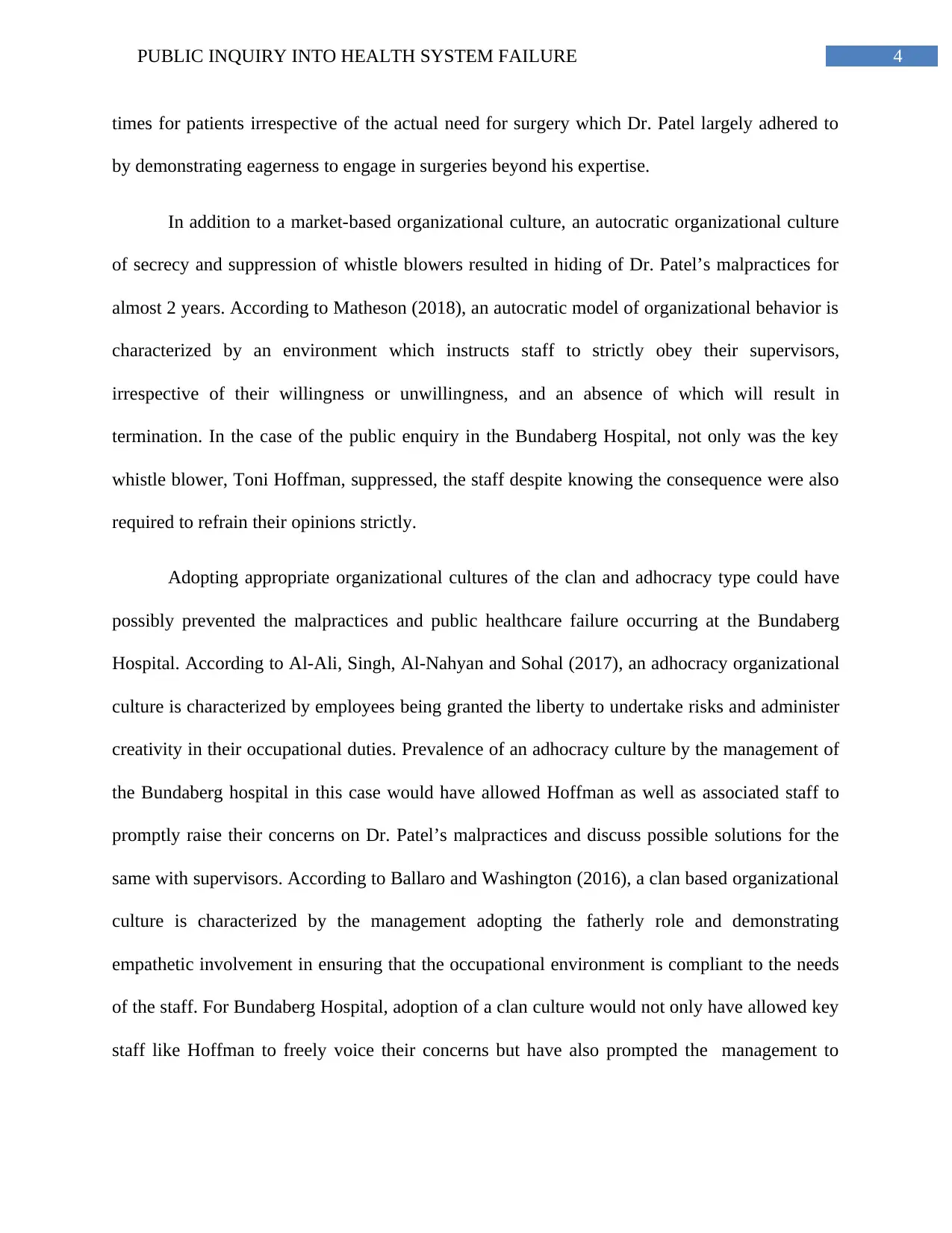
4PUBLIC INQUIRY INTO HEALTH SYSTEM FAILURE
times for patients irrespective of the actual need for surgery which Dr. Patel largely adhered to
by demonstrating eagerness to engage in surgeries beyond his expertise.
In addition to a market-based organizational culture, an autocratic organizational culture
of secrecy and suppression of whistle blowers resulted in hiding of Dr. Patel’s malpractices for
almost 2 years. According to Matheson (2018), an autocratic model of organizational behavior is
characterized by an environment which instructs staff to strictly obey their supervisors,
irrespective of their willingness or unwillingness, and an absence of which will result in
termination. In the case of the public enquiry in the Bundaberg Hospital, not only was the key
whistle blower, Toni Hoffman, suppressed, the staff despite knowing the consequence were also
required to refrain their opinions strictly.
Adopting appropriate organizational cultures of the clan and adhocracy type could have
possibly prevented the malpractices and public healthcare failure occurring at the Bundaberg
Hospital. According to Al-Ali, Singh, Al-Nahyan and Sohal (2017), an adhocracy organizational
culture is characterized by employees being granted the liberty to undertake risks and administer
creativity in their occupational duties. Prevalence of an adhocracy culture by the management of
the Bundaberg hospital in this case would have allowed Hoffman as well as associated staff to
promptly raise their concerns on Dr. Patel’s malpractices and discuss possible solutions for the
same with supervisors. According to Ballaro and Washington (2016), a clan based organizational
culture is characterized by the management adopting the fatherly role and demonstrating
empathetic involvement in ensuring that the occupational environment is compliant to the needs
of the staff. For Bundaberg Hospital, adoption of a clan culture would not only have allowed key
staff like Hoffman to freely voice their concerns but have also prompted the management to
times for patients irrespective of the actual need for surgery which Dr. Patel largely adhered to
by demonstrating eagerness to engage in surgeries beyond his expertise.
In addition to a market-based organizational culture, an autocratic organizational culture
of secrecy and suppression of whistle blowers resulted in hiding of Dr. Patel’s malpractices for
almost 2 years. According to Matheson (2018), an autocratic model of organizational behavior is
characterized by an environment which instructs staff to strictly obey their supervisors,
irrespective of their willingness or unwillingness, and an absence of which will result in
termination. In the case of the public enquiry in the Bundaberg Hospital, not only was the key
whistle blower, Toni Hoffman, suppressed, the staff despite knowing the consequence were also
required to refrain their opinions strictly.
Adopting appropriate organizational cultures of the clan and adhocracy type could have
possibly prevented the malpractices and public healthcare failure occurring at the Bundaberg
Hospital. According to Al-Ali, Singh, Al-Nahyan and Sohal (2017), an adhocracy organizational
culture is characterized by employees being granted the liberty to undertake risks and administer
creativity in their occupational duties. Prevalence of an adhocracy culture by the management of
the Bundaberg hospital in this case would have allowed Hoffman as well as associated staff to
promptly raise their concerns on Dr. Patel’s malpractices and discuss possible solutions for the
same with supervisors. According to Ballaro and Washington (2016), a clan based organizational
culture is characterized by the management adopting the fatherly role and demonstrating
empathetic involvement in ensuring that the occupational environment is compliant to the needs
of the staff. For Bundaberg Hospital, adoption of a clan culture would not only have allowed key
staff like Hoffman to freely voice their concerns but have also prompted the management to
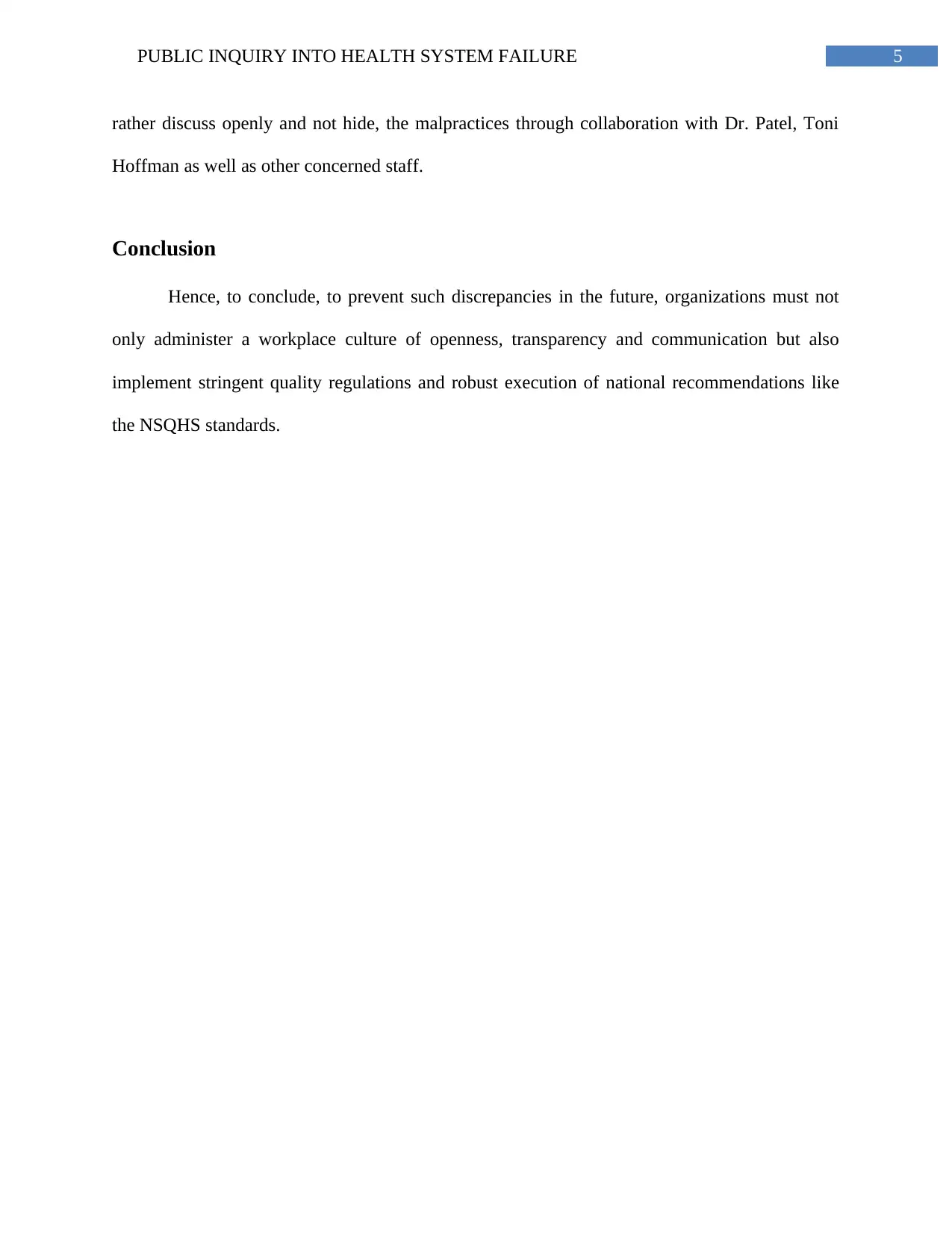
5PUBLIC INQUIRY INTO HEALTH SYSTEM FAILURE
rather discuss openly and not hide, the malpractices through collaboration with Dr. Patel, Toni
Hoffman as well as other concerned staff.
Conclusion
Hence, to conclude, to prevent such discrepancies in the future, organizations must not
only administer a workplace culture of openness, transparency and communication but also
implement stringent quality regulations and robust execution of national recommendations like
the NSQHS standards.
rather discuss openly and not hide, the malpractices through collaboration with Dr. Patel, Toni
Hoffman as well as other concerned staff.
Conclusion
Hence, to conclude, to prevent such discrepancies in the future, organizations must not
only administer a workplace culture of openness, transparency and communication but also
implement stringent quality regulations and robust execution of national recommendations like
the NSQHS standards.
⊘ This is a preview!⊘
Do you want full access?
Subscribe today to unlock all pages.

Trusted by 1+ million students worldwide
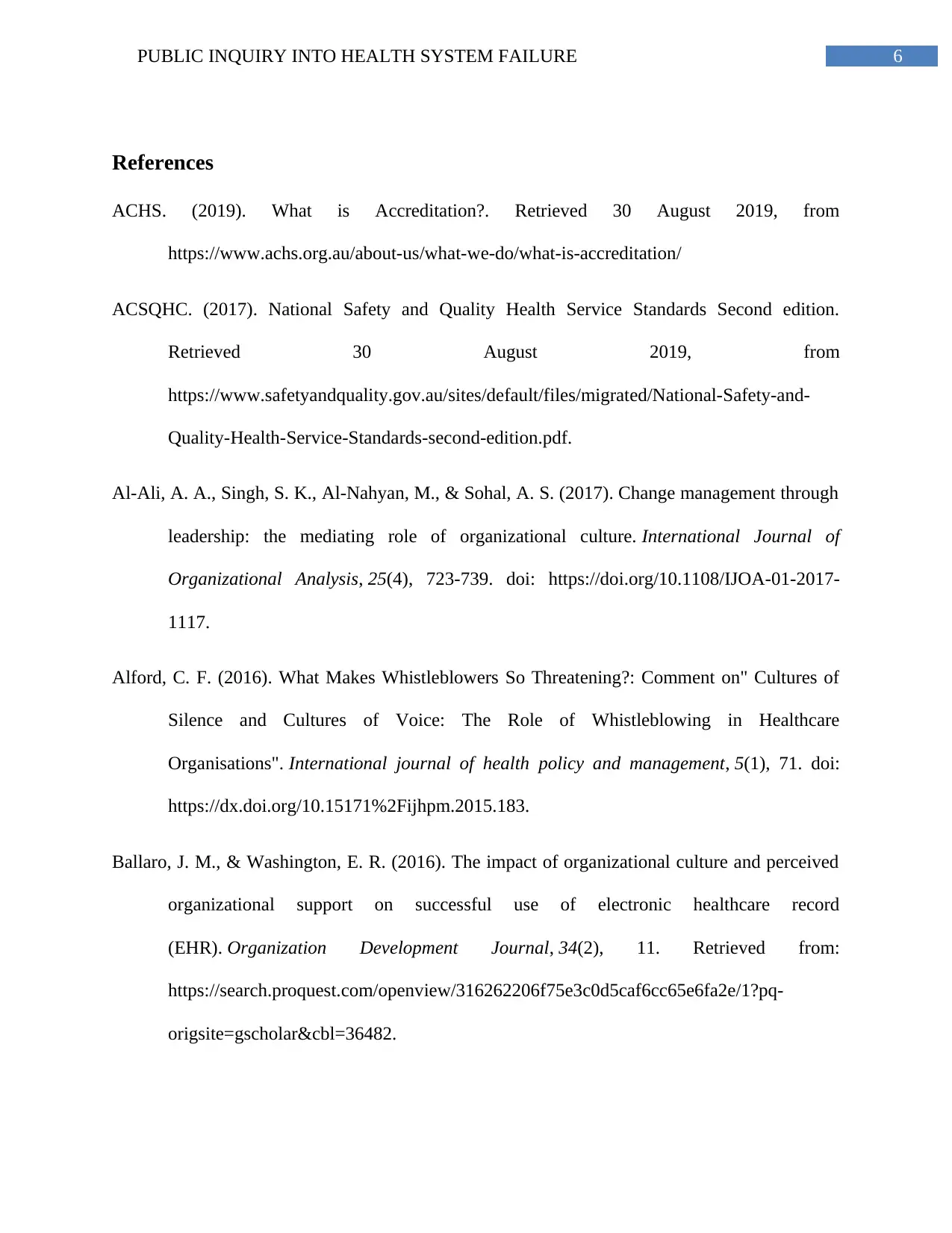
6PUBLIC INQUIRY INTO HEALTH SYSTEM FAILURE
References
ACHS. (2019). What is Accreditation?. Retrieved 30 August 2019, from
https://www.achs.org.au/about-us/what-we-do/what-is-accreditation/
ACSQHC. (2017). National Safety and Quality Health Service Standards Second edition.
Retrieved 30 August 2019, from
https://www.safetyandquality.gov.au/sites/default/files/migrated/National-Safety-and-
Quality-Health-Service-Standards-second-edition.pdf.
Al-Ali, A. A., Singh, S. K., Al-Nahyan, M., & Sohal, A. S. (2017). Change management through
leadership: the mediating role of organizational culture. International Journal of
Organizational Analysis, 25(4), 723-739. doi: https://doi.org/10.1108/IJOA-01-2017-
1117.
Alford, C. F. (2016). What Makes Whistleblowers So Threatening?: Comment on" Cultures of
Silence and Cultures of Voice: The Role of Whistleblowing in Healthcare
Organisations". International journal of health policy and management, 5(1), 71. doi:
https://dx.doi.org/10.15171%2Fijhpm.2015.183.
Ballaro, J. M., & Washington, E. R. (2016). The impact of organizational culture and perceived
organizational support on successful use of electronic healthcare record
(EHR). Organization Development Journal, 34(2), 11. Retrieved from:
https://search.proquest.com/openview/316262206f75e3c0d5caf6cc65e6fa2e/1?pq-
origsite=gscholar&cbl=36482.
References
ACHS. (2019). What is Accreditation?. Retrieved 30 August 2019, from
https://www.achs.org.au/about-us/what-we-do/what-is-accreditation/
ACSQHC. (2017). National Safety and Quality Health Service Standards Second edition.
Retrieved 30 August 2019, from
https://www.safetyandquality.gov.au/sites/default/files/migrated/National-Safety-and-
Quality-Health-Service-Standards-second-edition.pdf.
Al-Ali, A. A., Singh, S. K., Al-Nahyan, M., & Sohal, A. S. (2017). Change management through
leadership: the mediating role of organizational culture. International Journal of
Organizational Analysis, 25(4), 723-739. doi: https://doi.org/10.1108/IJOA-01-2017-
1117.
Alford, C. F. (2016). What Makes Whistleblowers So Threatening?: Comment on" Cultures of
Silence and Cultures of Voice: The Role of Whistleblowing in Healthcare
Organisations". International journal of health policy and management, 5(1), 71. doi:
https://dx.doi.org/10.15171%2Fijhpm.2015.183.
Ballaro, J. M., & Washington, E. R. (2016). The impact of organizational culture and perceived
organizational support on successful use of electronic healthcare record
(EHR). Organization Development Journal, 34(2), 11. Retrieved from:
https://search.proquest.com/openview/316262206f75e3c0d5caf6cc65e6fa2e/1?pq-
origsite=gscholar&cbl=36482.
Paraphrase This Document
Need a fresh take? Get an instant paraphrase of this document with our AI Paraphraser
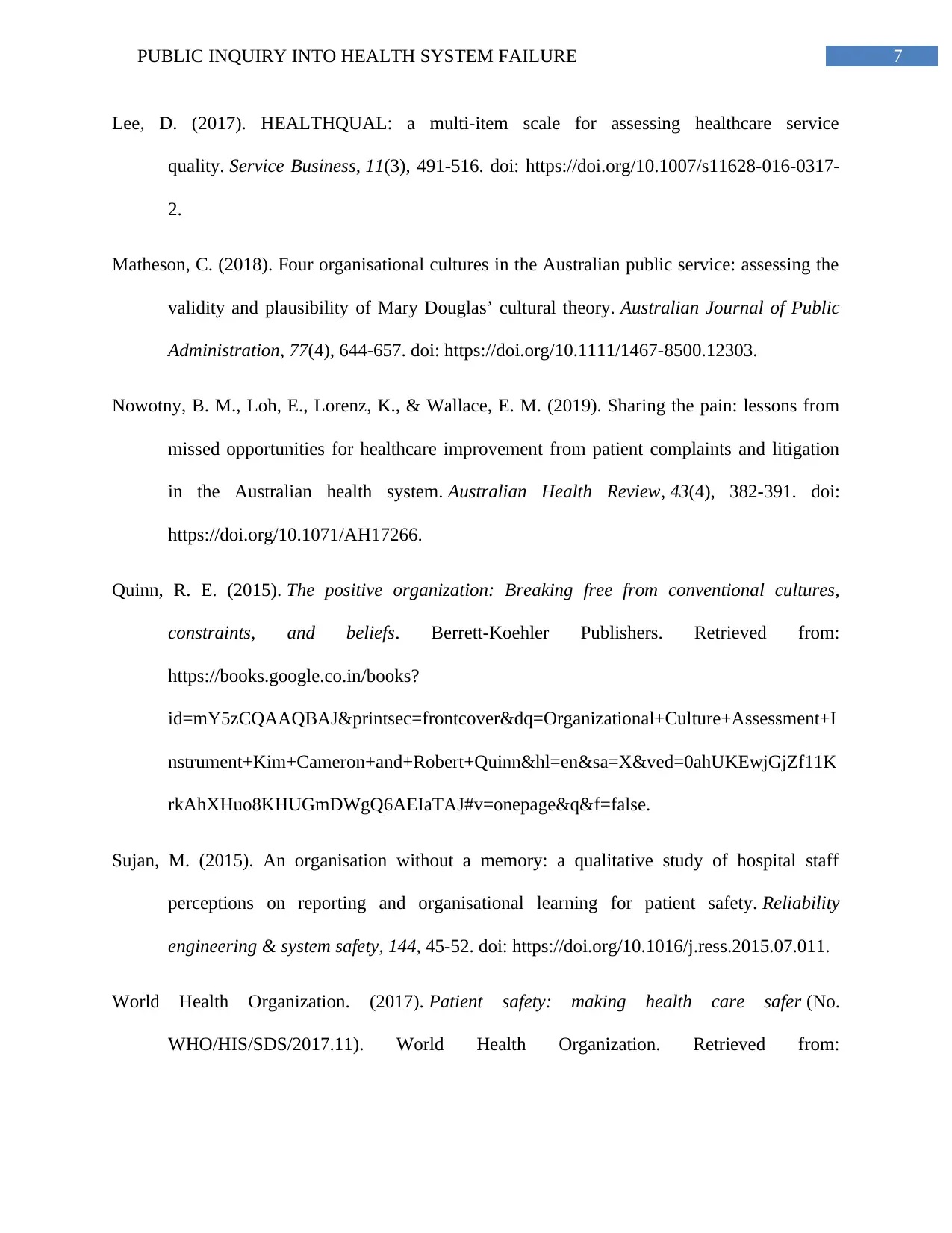
7PUBLIC INQUIRY INTO HEALTH SYSTEM FAILURE
Lee, D. (2017). HEALTHQUAL: a multi-item scale for assessing healthcare service
quality. Service Business, 11(3), 491-516. doi: https://doi.org/10.1007/s11628-016-0317-
2.
Matheson, C. (2018). Four organisational cultures in the Australian public service: assessing the
validity and plausibility of Mary Douglas’ cultural theory. Australian Journal of Public
Administration, 77(4), 644-657. doi: https://doi.org/10.1111/1467-8500.12303.
Nowotny, B. M., Loh, E., Lorenz, K., & Wallace, E. M. (2019). Sharing the pain: lessons from
missed opportunities for healthcare improvement from patient complaints and litigation
in the Australian health system. Australian Health Review, 43(4), 382-391. doi:
https://doi.org/10.1071/AH17266.
Quinn, R. E. (2015). The positive organization: Breaking free from conventional cultures,
constraints, and beliefs. Berrett-Koehler Publishers. Retrieved from:
https://books.google.co.in/books?
id=mY5zCQAAQBAJ&printsec=frontcover&dq=Organizational+Culture+Assessment+I
nstrument+Kim+Cameron+and+Robert+Quinn&hl=en&sa=X&ved=0ahUKEwjGjZf11K
rkAhXHuo8KHUGmDWgQ6AEIaTAJ#v=onepage&q&f=false.
Sujan, M. (2015). An organisation without a memory: a qualitative study of hospital staff
perceptions on reporting and organisational learning for patient safety. Reliability
engineering & system safety, 144, 45-52. doi: https://doi.org/10.1016/j.ress.2015.07.011.
World Health Organization. (2017). Patient safety: making health care safer (No.
WHO/HIS/SDS/2017.11). World Health Organization. Retrieved from:
Lee, D. (2017). HEALTHQUAL: a multi-item scale for assessing healthcare service
quality. Service Business, 11(3), 491-516. doi: https://doi.org/10.1007/s11628-016-0317-
2.
Matheson, C. (2018). Four organisational cultures in the Australian public service: assessing the
validity and plausibility of Mary Douglas’ cultural theory. Australian Journal of Public
Administration, 77(4), 644-657. doi: https://doi.org/10.1111/1467-8500.12303.
Nowotny, B. M., Loh, E., Lorenz, K., & Wallace, E. M. (2019). Sharing the pain: lessons from
missed opportunities for healthcare improvement from patient complaints and litigation
in the Australian health system. Australian Health Review, 43(4), 382-391. doi:
https://doi.org/10.1071/AH17266.
Quinn, R. E. (2015). The positive organization: Breaking free from conventional cultures,
constraints, and beliefs. Berrett-Koehler Publishers. Retrieved from:
https://books.google.co.in/books?
id=mY5zCQAAQBAJ&printsec=frontcover&dq=Organizational+Culture+Assessment+I
nstrument+Kim+Cameron+and+Robert+Quinn&hl=en&sa=X&ved=0ahUKEwjGjZf11K
rkAhXHuo8KHUGmDWgQ6AEIaTAJ#v=onepage&q&f=false.
Sujan, M. (2015). An organisation without a memory: a qualitative study of hospital staff
perceptions on reporting and organisational learning for patient safety. Reliability
engineering & system safety, 144, 45-52. doi: https://doi.org/10.1016/j.ress.2015.07.011.
World Health Organization. (2017). Patient safety: making health care safer (No.
WHO/HIS/SDS/2017.11). World Health Organization. Retrieved from:
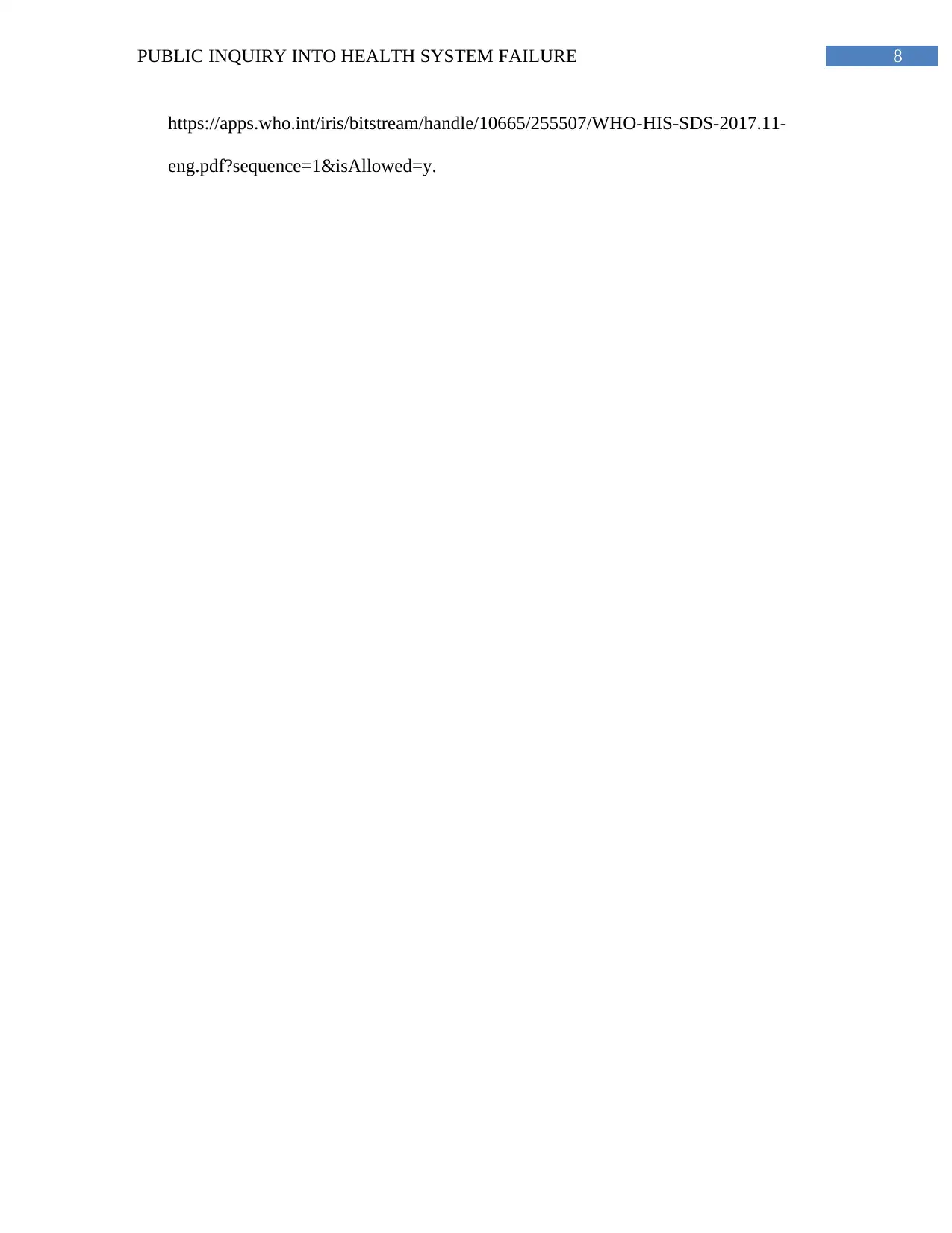
8PUBLIC INQUIRY INTO HEALTH SYSTEM FAILURE
https://apps.who.int/iris/bitstream/handle/10665/255507/WHO-HIS-SDS-2017.11-
eng.pdf?sequence=1&isAllowed=y.
https://apps.who.int/iris/bitstream/handle/10665/255507/WHO-HIS-SDS-2017.11-
eng.pdf?sequence=1&isAllowed=y.
⊘ This is a preview!⊘
Do you want full access?
Subscribe today to unlock all pages.

Trusted by 1+ million students worldwide
1 out of 9
Related Documents
Your All-in-One AI-Powered Toolkit for Academic Success.
+13062052269
info@desklib.com
Available 24*7 on WhatsApp / Email
![[object Object]](/_next/static/media/star-bottom.7253800d.svg)
Unlock your academic potential
Copyright © 2020–2025 A2Z Services. All Rights Reserved. Developed and managed by ZUCOL.





